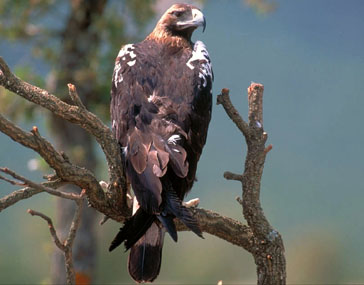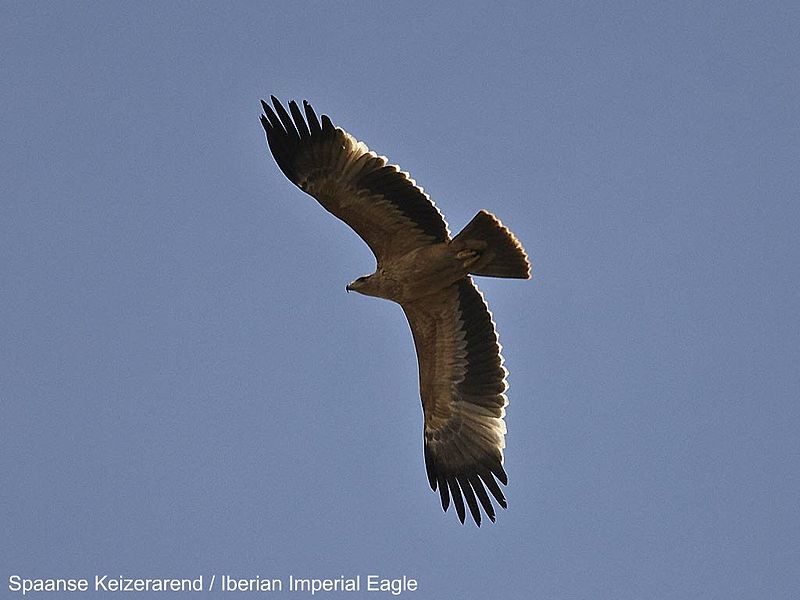Spanish Imperial Eagle - Aquila adalberti
[Author unknown] GFDL, via Wikimedia Commons
Family: Accipitridae
Genus: Aquila
Species: A. adalberti
Spanish Imperial Eagles are large birds of prey that live in the Iberian Peninsula. They were considered a subspecies of Aquila heliaca (Eastern Imperial Eagle), but based on morphological, ecological, and molecular differences the two species have been separated. They form a clade with A. heliaca (Eastern Imperial Eagle), A. nipalensis (Steppe Eagle), and A. rapax (Tawny Eagle). They also form a superspecies with A. heliaca.
Physical Description:
Spanish Imperial Eagles are entirely brown, except for a cream-colored head and neck, white patches on the shoulders, and a gray uppertail.
Juveniles are rufous to pale brown with dark flight feathers and white edges.
Their call is a repeated "owk". They can live to be 31 years old, with an average lifespan of 16.4.
Size:
Length: 75-84 cm
Wingspan: 180-210 cm
Weight: 2.5-3.5 kg
Habitat and Distribution:
They inhabit woodland, plains, and marshes, and they are sometimes found along mountain slopes.
Spanish Imperial Eagles live in central and southwestern Spain. Vagrants have been recorded in the Netherlands, France, Morocco, and Senegal. They used to be breed in Portugal, Algeria, and Morocco, but their range has decreased to include only Spain. Adults are sedentary, but juveniles disperse up to 310 km from their breeding areas, with an average distance of 101.2 km. There are an estimated 300-400 individuals across a range of 117,000 km².
By Antonio Lucio Carrasco Gómez, GFDL, via Wikimedia Commons
Diet and Hunting:
Their usual diet consists mainly of rabbits. Other prey includes carrion, reptiles and hares, in addition to pigeons, partridges, and other birds up to the size of flamingos in wetter areas.
Reproduction:
The breeding season begins in February. Pairs are monogamous and they have an average territory size of 52 km².
The nest is built out of sticks and placed in a tree. Spanish Imperial Eagles rarely build their nests on an electricity pylon and they avoid cliffs altogether, unlike some other eagle species. 1-4 eggs are laid, usually 2-3, and are incubated by the female for 39-42 days; the male rarely takes over incubation. After hatching, siblicide (where the older, stronger chick kills the younger) and sibling competition result in 58.4% of all nestling deaths. Fledging takes 69-83 days and the young are dependent on their parents for 3-6 weeks after that.
Conservation:
Spanish Imperial Eagles have been shot, poisoned, and caught in traps to the point where there were only 30 pairs remaining in the 1960s. From 1970-1990, the population stabilized and expanded up to the current 300-400 individuals; however, deforestation, electrocution, intentional poisoning, and chemical contamination make up some of the more recent threats, and when a virus swept through the rabbit population decimating its numbers, the eagle population also dropped. Spanish Imperial Eagles are currently listed as Vulnerable by BirdLife International.
By Martien Brand, CC-BY-2.0, via Wikimedia Commons
Conservation measures undertaken include legal protection in Spain and the drafting of a European Action Plan in 1996. Dangerous electricity towers have been modified, feeding programs instituted, and nest monitoring has increased the eagles’ breeding success. In addition, two pairs were recently reintroduced to Portugal.
Conservation measures proposed include reducing the mortality rate from poisoning and electrocution, annual surveys of the population, maintenance of protected areas, continuation of nest monitoring and feeding programs, and avoiding building wind farms.
Taxonomy:
Aquila adalberti was formerly considered a subspecies of Aquila heliaca (Eastern Imperial Eagle), but they have been classified as separate species by several authorities due to morphological, ecological, and molecular differences. They are thought to have split along different evolutionary lines during the late Pleistocene or Holocene Epoch.
A. adalberti forms a clade with A. heliaca (Eastern Imperial Eagle), A. nipalensis (Steppe Eagle), and A. rapax (Tawny Eagle). It forms a superspecies with A. heliaca.
The name adalberti is a derivative of the name Adalbert, of Prince Adalbert of Bavaria.
Other Names:
Adalbert’s Eagle, Iberian Imperial Eagle, Imperial Eagle, White-Shouldered Eagle, Orel iberský (Czech), Spansk Kejserørn (Danish), Spaanse Keizerarend (Dutch), Ibeeria kääpakotkas (Estonian), Iberiankeisarikotka (Finnish), Aigle ibérique (French), Spanischer Kaiseradler (German), Skassörn (Icelandic), Aquila imperial spagnola (Italian), Nishikatajirowashi (Japanese), Orzel iberyjski (Polish), Águia-imperial-ibérica (Portuguese), Águila Imperial Ibérica (Spanish).
Video of Spanish Imperial Eagles:
References:
http://www.arkive.org/spanish-imperial-eagle/aquila-adalberti/
http://avibase.bsc-eoc.org/species.jsp?avibaseid=69742EE44F0A1463
BirdLife International (2012) Species factsheet: Aquila adalberti. Downloaded from http://www.birdlife.org on 16/03/2012.
http://ec.europa.eu/environment/nature/conservation/wildbirds/action_plans/docs/aquila_adalberti.pdf
http://www.europeanraptors.org/raptors/spanish_imperial_eagle.html
Global Raptor Information Network. 2012. Species account: Spanish Imperial Eagle Aquila adalberti. Downloaded from
http://www.globalraptors.org on 16 Mar. 2012
http://ibc.lynxeds.com/species/spanish-imperial-eagle-aquila-adalberti
BirdLife International 2008. Aquila adalberti. In: IUCN 2011. IUCN Red List of Threatened Species. Version 2011.2.
www.iucnredlist.org. Downloaded on 16 March 2012.
http://www.planetofbirds.com/accipitriformes-accipitridae-spanish-imperial-eagle-aquila-adalberti
http://www.scientificlib.com/en/Biology/Animalia/Chordata/Aves/AquilaAdalberti01.html


